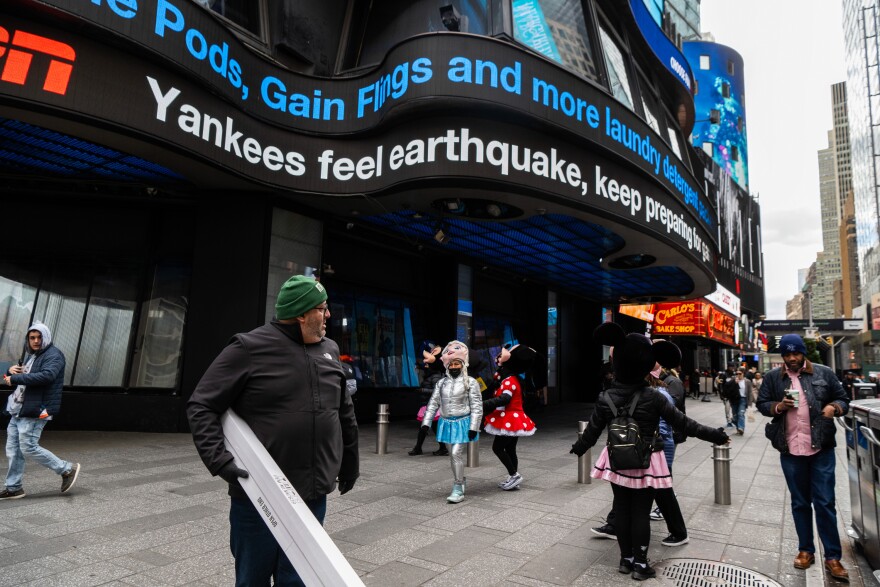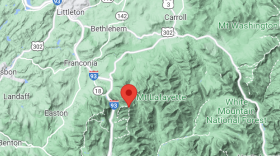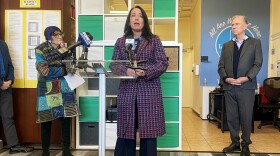An earthquake centered in New Jersey shook portions of Connecticut Friday morning, the U.S. Geological Survey said, rattling residents and shaking buildings in an area where people are unaccustomed to feeling the ground move.
The agency reported a quake at 10:23 a.m. with a preliminary magnitude of 4.8, centered near Lebanon, New Jersey, or about 45 miles west of New York City.
USGS figures indicated that the quake might have been felt by more than 42 million people.
In Connecticut, there were no immediate reports of any damage or problems from the earthquake, the Connecticut State Police said Friday morning.
Friday's quake was notable for the region, CT state geologist says
Meghan Seremet, the Connecticut State Geologist, said she was on a call with other geologists Friday morning when the ground started shaking.
"It was timely," she joked. "All of a sudden my monitors start shaking. My chairs start shaking. And I immediately go to the USGS website and [ask] is there an earthquake happening here? Did you feel it? And a minute later, we're all like, 'Yes.'"
While Friday's earthquake was centered in New Jersey, Seremet said the quake was relatively shallow — about 2 miles underground — allowing it to be felt in Connecticut.
"It's not too common to have earthquakes of this magnitude in New England," Seremet said. "In Connecticut, we do have fairly common earthquakes, less than a magnitude of 2. But anything greater than a 3 is uncommon in Connecticut."
People throughout Northeast report feeling rattles from the quake
People in Baltimore, Philadelphia, Connecticut, and across New England reported shaking.
Felipe Rodriguez was working his job in security at The Bruce Museum in Greenwich, Connecticut, when he noticed envelopes moving and papers beginning to vibrate.
"Between the vibration and the noise, you actually had a good audible noise ... it increases your anxiety," Rodriguez said.
Rodriguez said he had felt an earthquake before, in Peru, so he recognized what was happening.
"It ended up starting very slowly at first, and then it felt like a big train was coming next to the building," Rodriguez recalled. "It just ended up increasing and increasing, and we actually saw the physical shaking of objects in the museum."
Gov. Ned Lamont said state and local officials were continuing to monitor the situation.
We are working with @CTDEMHS and local emergency management officials in response to the earthquake that was felt in Connecticut this morning. Stay alert for any updates from local officials. https://t.co/JMryJgm6Ob
— Governor Ned Lamont (@GovNedLamont) April 5, 2024
The state's emergency operations center was partially activated in response to the earthquake, state officials said.
"We're monitoring, we are not seeing any significant damage," said Brenda Bergeron, deupty commissioner of the state Division of Emergency Management and Homeland Security.
Both Eversource and United Illuminating reported no major outages following the earthquake. Bergeron said utilities were inspecting electrical infrastructure, but they reported no immediate issues.
Millstone Power Station, a nuclear power plant in Waterford, was also continuing to operate normally, Bergeron said, with no apparent impact to operations. "They're operating at 100% power and they see no life-safety issues at this time," she said.
State officials were also doing visual inspections of bridges and infrastructure across the state, Bergeron said.
Amtrak said it was inspecting its tracks and had speed restrictions in place throughout the busy Northeast Corridor. New Jersey Transit posted on X that its train system was subject to delays caused by bridge inspections. The Philadelphia area's PATCO rail line suspended service out of what it said was "an abundance of caution.”
The White House said in a statement that President Joe Biden had been briefed on the earthquake and was “in touch with federal, state, and local officials as we learn more.”
State officials said people should inspect their homes, and if they notice any new cracks that may have been caused by the earthquake, they should tell local town or city officials.
No active faults, but pressure and rocks contribute to Northeast quakes, geologists say
Earthquakes are generally rare in New England, but small quakes and infrequent larger ones have rattled the land since colonial times.
"We have had large earthquakes in the past. [But] we are not on an active fault zone, like western California," Seremet, the Connecticut geologist, said. "We have inactive faults here."
But sometimes pressure can build up on those inactive faults, and when that pressure gets released, the region can see small quakes, she said.
Robert Thorson, an earth sciences professor at the University of Connecticut, said East Coast quakes like Friday's are caused by compression over time of hard, brittle rock deep underground.
“It’s like having a big block of ice in a vise and you are just slowly cranking up the vise,” Thorson said. "Eventually, you’re going to get some crackling on it.”
Those quakes can still pack a punch, as rocks on the East Coast are better than their western counterparts at spreading earthquake energy across long distances.
“If we had the same magnitude quake in California, it probably wouldn’t be felt nearly as far away,” said USGS geophysicist Paul Caruso.
Last month, a minor earthquake rattled portions of southeastern Connecticut shaking buildings and causing loud booms.
It's uncommon, but seismic slams do hit New England
Damaging earthquakes are extremely uncommon in the Northeast, but they do happen.
“Moderately damaging earthquakes strike somewhere in the region every few decades, and smaller earthquakes are felt roughly twice a year,” according to the USGS.
In the middle 1700s, the Boston area was damaged three times within 28 years from earthquakes. Earthquakes with magnitudes near or above 5 struck near New York City in 1737, 1783 and 1884, the USGS said.
Thorson, the UConn professor, said booms, rumblings and rattling have been recorded for centuries in the East Hampton area, including the nearby village of Moodus. A larger earthquake, recorded on May 16, 1791, knocked down stone walls and chimneys.
In fact, Moodus is short for “Machimoodus” or “Mackimoodus,” which means “place of bad noises” in the Algonquian dialects once spoken in the area. A local high school has even nicknamed their teams “The Noises” in honor of that history.
"The largest known New England earthquakes occurred in 1638 (magnitude 6.5) in Vermont or New Hampshire, and in 1755 (magnitude 5.8) offshore from Cape Ann northeast of Boston," according to the USGS.
"The Cape Ann earthquake caused severe damage to the Boston waterfront," the agency reports. "The most recent New England earthquake to cause moderate damage occurred in 1940 (magnitude 5.6) in central New Hampshire."
Residents recall 2011 earthquake that jolted region
The shaking stirred memories of the Aug. 23, 2011, earthquake that jolted tens of millions of people from Georgia to Canada. Registering magnitude 5.8, it was the strongest quake to hit the East Coast since World War II. The epicenter was in Virginia.
That earthquake left cracks in the Washington Monument, spurred the evacuation of the White House and Capitol and rattled New Yorkers three weeks before the 10th anniversary of the Sept. 11 terror attacks.
This story has been updated. Connecticut Public's Matt Dwyer, Michayla Savitt, Patrick Skahill and The Associated Press contributed to this report.




